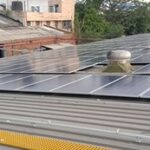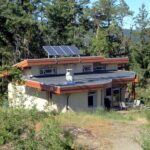Researchers Develop Technique to Improve Durability of Perovskite Solar Cells
Researchers Develop Technique to Improve Durability of Perovskite Solar Cells
A team of international researchers has developed a new technique that could significantly enhance the durability of perovskite solar cells, a promising emerging technology in photovoltaics. The technique, described in a recent study published in Science, could be an essential step towards commercializing perovskite solar cells and reducing their cost.
Perovskite solar cells are different from traditional solar cells as they are made from nano-sized crystals rather than high-purity silicon wafers. The perovskite crystals are dispersed into a liquid and spin-coated onto a surface using low-cost and well-established techniques. These types of solar cells have the potential to overcome the inherent efficiency limitations of silicon solar cells.
One key vulnerability point is the interface between the perovskite layer and the adjacent layers, called the carrier transport layer. These adjacent layers extract the electrons or holes flowing through the circuit. In cases where the chemical bonding between these layers and the perovskite layer gets damaged by light or heat, the electrons or holes can’t get into the circuit, which lowers the cell’s overall efficiency.
To address this issue, the international research team used computer simulations based on density functional theory (DFT) to predict what kind of molecules would best create a bridge between the perovskite layer and the charge transport layers. The simulations predicted that Lewis acids containing phosphorus would have the best effect.
In the lab, the team tried out various formulations of phosphorus-containing molecules and discovered that the best performance came from a material known as 1,3 bis (diphenylphosphino)propane, or DPPP. The team built inverted perovskite solar cells that contained DPPP and some without it. The team found that, with DPPP, the overall power conversion efficiency of the cell stayed high for approximately 3,500 hours under ambient conditions, without additional heating. This represents a considerable improvement compared to previous records, where perovskite solar cells tend to see a significant drop in their efficiency after 1,500 to 2,000 hours.
The team has applied for a patent for the DPPP technique and has received interest from commercial solar cell manufacturers. The researchers believe that their approach represents a new path forward, where DFT simulations and rational design can point the way towards promising solutions.
In recent months, other researchers have also made strides in perovskite solar cell research. Researchers at the École Polytechnique fédérale de Lausanne and Sungkyunkwan University in South Korea identified the cause behind the degradation of perovskite solar cells and developed a technique to improve their stability. Meanwhile, researchers at the Helmholtz-Zentrum Berlin achieved efficiencies of well above 24% for perovskite solar cells that are resistant to drop under rapid temperature fluctuations between -60 and +80 degrees Celsius over one hundred cycles.
The progress being made in perovskite solar cell research is exciting and shows promising potential for this technology to play a significant role in meeting our energy needs in the future. With continued development and investment, perovskite solar cells could become a cost-effective and efficient solution for renewable energy generation.
Suggested Articles

Rooftop Solar: Reduce Your Electricity Bill and Increase Savings
Discover how installing a rooftop solar system can help you save on electricity bills, reduce peak demand charges, and take advantage of government incentives.

Everything you Need to Know about Bifacial Solar Panels technology
Learn how bifacial solar panels capture sunlight on both sides, boosting energy efficiency and maximizing solar power generation for homes and businesses.

Group Net Metering for Solar Projects: A Smart Way to Maximize Solar Energy Generation
Discover how group net metering allows multiple participants to share solar energy from a single project, reduce electricity bills, and enhance solar efficiency.

Law Change Makes It Hard to Receive Compensation for Solar Developers
A recent law change creates hurdles for solar developers seeking compensation, impacting project viability.

Solar Chankya: Complete Guide to Solar Systems and Components
Discover the key components of solar systems—from panels to inverters and batteries—and how they work together for efficient energy solutions

Financing made easy for the Rooftop Solar Projects
Switching to solar is easier than ever with flexible financing options. This guide explains how to fund your rooftop solar project through loans, subsidies, and government schemes to make clean energy more affordable and sustainable.

Solar Projects Challenges in India: Module Supply Shortages and Policy Delays Slow Growth
India’s utility-scale solar projects face delays due to module supply shortages and policy challenges, impacting the growth of renewable energy.

Go Off-Grid with Solar Energy: A Complete Guide
Living off-grid, more commonly defined as not having a dependence on public utilities such as electricity, sounds appealing for a lot of reasons. The idea of being self-sufficient, powering your own home with solar energy, and maybe even building that home with your own two hands can sound like a dream and a challenge for people who wish to live life on their terms.